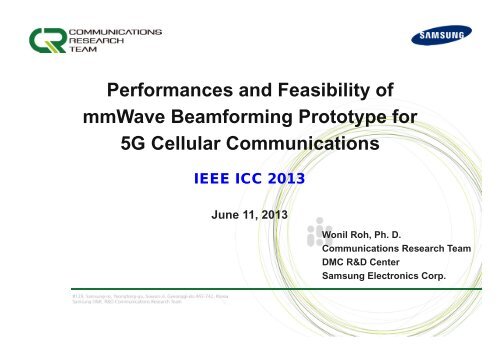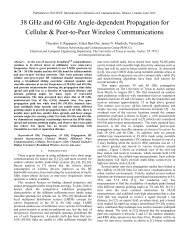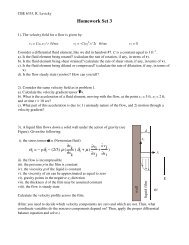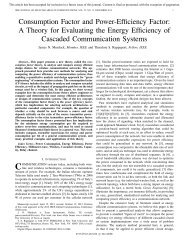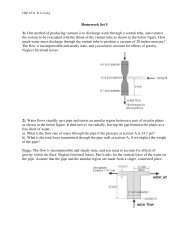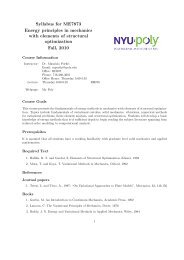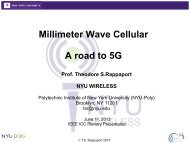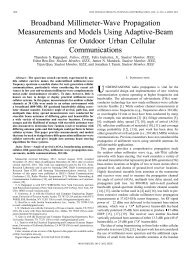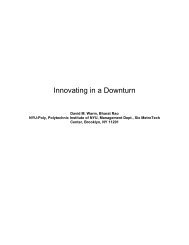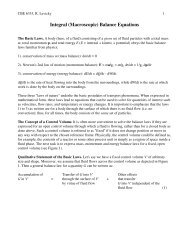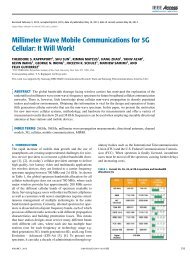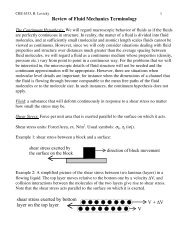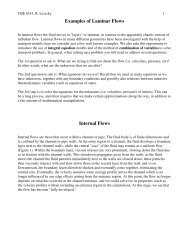Samsung Vision at ICC 2013 by Wonil Roh
Samsung Vision at ICC 2013 by Wonil Roh
Samsung Vision at ICC 2013 by Wonil Roh
You also want an ePaper? Increase the reach of your titles
YUMPU automatically turns print PDFs into web optimized ePapers that Google loves.
CONTENTS1. 5G <strong>Vision</strong>2. 5G Key Enabling Technologies3. mmWave Channel Propag<strong>at</strong>ion & Measurements4. mmWave BF Prototype & Algorithm5. Summary2
1. 5G <strong>Vision</strong>© <strong>2013</strong> <strong>Samsung</strong> DMC R&D Communic<strong>at</strong>ions Research Team 3
5G Service <strong>Vision</strong>Wearable/Flexible Mobile DeviceUbiquitous Health CareMobile CloudUHD Video StreamingSmart Map/Navig<strong>at</strong>ionReal‐Time Interactive Game© <strong>2013</strong> <strong>Samsung</strong> DMC R&D Communic<strong>at</strong>ions Research Team 4
5G Key Performance TargetsProviding Gigabit Experience to Users Anywhere5G PerformancesD<strong>at</strong>a R<strong>at</strong>ePeak D<strong>at</strong>a R<strong>at</strong>e > 50 Gbps50 Times Faster than 4G14 Mbps 1) 1 Gbps 1) 50 Gbps 1)5384 75 Gbps 2)Kbps 2) Mbps 2)Year1) 2)Theoretical Peak D<strong>at</strong>a R<strong>at</strong>e D<strong>at</strong>a R<strong>at</strong>e of First Commercial ProductsL<strong>at</strong>ency < 1 msec4GAnywhere 1 GbpsBS Loc<strong>at</strong>ionsQoECell EdgeQoE5GBS Loc<strong>at</strong>ions10 ms1 ms A Tenth of 4G L<strong>at</strong>encyUniform ExperienceRegardless of Loc<strong>at</strong>ionL<strong>at</strong>ency© <strong>2013</strong> <strong>Samsung</strong> DMC R&D Communic<strong>at</strong>ions Research Team 5
2. 5G Key Enabling Technologies© <strong>2013</strong> <strong>Samsung</strong> DMC R&D Communic<strong>at</strong>ions Research Team 6
5G Key Enabling Technologies (2/2)Disruptive Technologies for Significant Performance EnhancementEnhanced Fl<strong>at</strong> NWIWK/Integr<strong>at</strong>ion w/ Wi‐FiAdv. MIMO/BFHalf‐wavelengthInterference ManagementLarge scaleMulti‐antennaInterference alignment© <strong>2013</strong> <strong>Samsung</strong> DMC R&D Communic<strong>at</strong>ions Research Team .8
Spectrum Candid<strong>at</strong>esCandid<strong>at</strong>es for Large Chunks of Contiguous Spectrum- 13.4~14 GHz, 18.1~18.6 GHz, 27~29.5 GHz, 38~39.5 GHz, etc.Higher Frequency Candid<strong>at</strong>esITUEESSFSSRLMSFSFSSMSFSFSSMSFSFSS27.5 29.5 31.3 33.8 38.6 40 41 42.526.5 29.5 31.3 33.4 40.2 42.513.4 14 18.1 18.6 27 29.5 38 39.5Current UsageUS: LMDS, FSSEU: Fixed P‐P link , FSS earth sta.China: Mobile, FSSKorea : Marine time useCurrent UsageUS: Fixed P‐P systemEU: Fixed P‐P linkKorea : NoneMOBILE PrimaryNo MOBILEEESS (Earth Explor<strong>at</strong>ion‐S<strong>at</strong>ellite Serivce) FSS (Fixed S<strong>at</strong>ellite Service) RL (RadioLoc<strong>at</strong>ion service),MS (Mobile Service) FS (Fixed Servce) P‐P (Point to Point) LMDS (Local Multipoint Distribution Services)© <strong>2013</strong> <strong>Samsung</strong> DMC R&D Communic<strong>at</strong>ions Research Team .10
Rain Attenu<strong>at</strong>ionRain Attenu<strong>at</strong>ion <strong>at</strong> 28GHz is Approx. 4 dB <strong>at</strong> 200 m even in 110 mm/hr IntensityPrecipit<strong>at</strong>ion□ 100‐year recurrence 1‐hour rain intensity is approx. 110 mm/hr (Seoul, Korea)□ 100‐year recurrence 1‐hour rain intensity is approx. 70 ~ 127 mm/hr (US Eastern)100 Year Recurrence 1‐hour Rain Intensity (US Eastern)New York: 69.85 mm/hrWashington: 76.2 mm/hrFlorida: 127 mm/hr[Attenu<strong>at</strong>ion due to Rain][Ref.] http://www.nws.noaa.gov/ohd/hdsc/On‐line_reports/[Ref.] M. Marcus and B. P<strong>at</strong>tan. Millimeter wave propag<strong>at</strong>ion: spectrum management implic<strong>at</strong>ions. IEEE Microwave Magazine, June 2005.© <strong>2013</strong> <strong>Samsung</strong> DMC R&D Communic<strong>at</strong>ions Research Team 15
Chassis / Hand / Power AbsorptionEffect of Chassis/Hand/Head Could Be Compens<strong>at</strong>ed with Beamsteering ArrayHigh Frequency Beamforming Reduces Power Penetr<strong>at</strong>ion/Absorption through SkinChassis / Hand-held Effect□ Chassis/hand impact on gain and p<strong>at</strong>ternBare PCB PackagePower Absorption□ Low penetr<strong>at</strong>ion and absorption due tohigh frequency beamforming1.9 GHz Omni-Antennaw/o headw/ head□ Various antenna loc<strong>at</strong>ions and BFp<strong>at</strong>terns can overcome these effectsPenetr<strong>at</strong>ion depth = 40~45 mm, Average = 0.29, MAX = 1 mW/g28 GHz Beamforming111BroadsideBeamformingEndfireBeamforming2221 Penetr<strong>at</strong>ion depth = 3 mm, Average = 0.15, MAX = 90 mW/g2 Penetr<strong>at</strong>ion depth = 3 mm, Average = 0.016, MAX = 2.11 mW/g© <strong>2013</strong> <strong>Samsung</strong> DMC R&D Communic<strong>at</strong>ions Research Team 17
Channel Measurement –Sub‐UrbanSimilar P<strong>at</strong>h‐loss Exponent & Smaller Delay Spread Measured (w.r.t current cellular bands)- Measurements were made <strong>by</strong> using horn‐type antennas <strong>at</strong> 28 GHz and 38 GHz in 2011<strong>Samsung</strong> Campus, KoreaLOSNLOSP<strong>at</strong>h Loss Exponent 2.22 3.69RMS Median 4.0 34.2Delay Spread [ns] 99% 11.4 168.7UT Austin Campus, USLOSNLOSP<strong>at</strong>h Loss Exponent 2.21 3.18RMS Median 1.9 15.5Delay Spread [ns] 99% 13.7 166Tx (10 o ) Rx (60 o )28 GHzUniversity of Texas <strong>at</strong> Austin, TXTx (7.8 o )37.6 GHzRx (49 o )Received power [dBm]0-10-20-30-40-50[Received Power]Received power for 10->60LOSn=2.22, s=4.18dBNLOS-bestn=3.69, s=3.58dBNLOS-alln=4.20, s=7.38dB[Received Power]-60-70510 1 10 2Distance [m]© <strong>2013</strong> <strong>Samsung</strong> DMC R&D Communic<strong>at</strong>ions Research Team * Reference : Prof. Ted Rappaport, UT Austin, 201119
Channel Measurement –Dense UrbanSlightly Higher But Comparable P<strong>at</strong>h Loss Measured in New York City in 2012New York, Manh<strong>at</strong>tan, USLOSNLOSP<strong>at</strong>h Loss Exponent 1.68 4.58Delay Spread [ns]Expected to be larger than the previous,But to be still smaller than current bandsTx (10 o ) Rx (10 o )28GHz[New York, Manh<strong>at</strong>tan –NY University][P<strong>at</strong>h Loss]* Reference : Prof. Ted Rappaport, NYU, 2012© <strong>2013</strong> <strong>Samsung</strong> DMC R&D Communic<strong>at</strong>ions Research Team 20
4. mmWave BF Prototype & Algorithm© <strong>2013</strong> <strong>Samsung</strong> DMC R&D Communic<strong>at</strong>ions Research Team 21
mmWave BF Prototype OverviewWorld’s First mmWave Mobile Technology- Adaptive array transceiver technology oper<strong>at</strong>ing in themillimeter‐wave frequency bands for outdoor cellularmmWave BF PrototypeCarrier FrequencyBandwidthMax. Tx PowerBeam width (Half Power)27.925 GHz500 MHz37 dBm10 oBase St<strong>at</strong>ion8x8 (=64) Antenna ElementsMobile St<strong>at</strong>ion66 mm66 mmArray AntennaDownlink TxUplink Tx44 mm51 mmArray AntennaBaseband ModemRF + Array AntennaDM(Diagnostic Monitor )RF + Array AntennaBaseband Modem© <strong>2013</strong> <strong>Samsung</strong> DMC R&D Communic<strong>at</strong>ions Research Team 22
Test Results of mmWave BF PrototypePerformance Tests of mmWave OFDM Prototype- OFDM system parameters designed for mmWave bands- Indoor & outdoor measurements performed for d<strong>at</strong>a r<strong>at</strong>es and transmission rangesSystem Parameters & Test ResultsPARAMETERVALUEPARAMETER VALUE REMARKSCarrier FrequencyBandwidth27.925 GHz500 MHzSupportedD<strong>at</strong>a R<strong>at</strong>es1,056Mbps528Mbps264MbpsDuplexingTDDMax Tx RangeUp to 2Km @ LoS>10 dB Tx powerheadroomArray Antenna Size8x8 (64 elements)8x4 (32 elements)Beam-width (Half Power)10 oChannel CodingLDPCModul<strong>at</strong>ionQPSK / 16QAMFull-HD Video Streaming TestMeasurements with DM© <strong>2013</strong> <strong>Samsung</strong> DMC R&D Communic<strong>at</strong>ions Research Team 23
Test Results –RangeOutdoor Line‐of‐Sight (LoS) Range Test- Error free communic<strong>at</strong>ions possible <strong>at</strong> 1.7 Km LoS with > 10dB Tx power headroom- Pencil BF both <strong>at</strong> transmitter and receiver supporting long range communic<strong>at</strong>ionsLoS Range□ Support wide‐range LoS coverage 16‐QAM (528Mbps) : BLER 10 ‐6 QPSK (264Mbps) : Error FreeSuwon Campus, Korea Base- 1710m LOS 측정 자료로 St<strong>at</strong>ion 수정 예정1.7 kmMobileSt<strong>at</strong>ionBLER : Block Error R<strong>at</strong>e QPSK : Quadr<strong>at</strong>ure Phase Shift Keying QAM : Quadr<strong>at</strong>ure Amplitude Modul<strong>at</strong>ion© <strong>2013</strong> <strong>Samsung</strong> DMC R&D Communic<strong>at</strong>ions Research Team 24
Test Results – MobilityOutdoor Non‐Line‐of‐Sight (NLoS) Mobility Tests- Fast Joint Beamforming & Tracking Supports 8 km/h Mobility even in NLOSMobility Support in NLoS□ Mobility support up to 8 Km/h <strong>at</strong> outdoorNLoS environments 16‐QAM (528Mbps) : BLER 0~0.5% QPSK (264Mbps) : Error FreeBaseSt<strong>at</strong>ionMobileSt<strong>at</strong>ion[ DM Screen during Mobility Test]© <strong>2013</strong> <strong>Samsung</strong> DMC R&D Communic<strong>at</strong>ions Research Team 25
Test Results – Building Penetr<strong>at</strong>ionMost Signals Successfully Received <strong>at</strong> Indoor MS from Outdoor BS- Outdoor‐to‐indoor penetr<strong>at</strong>ion made through tinted glasses and doorsOutdoor to Indoor #1□ Signal measured inside office on 7 th FL of R2- QPSK : BLER 0.0005~0.6% (Target : < BLER 10%)Outdoor to Indoor #2□ Signal measured inside the lob<strong>by</strong> <strong>at</strong> R4- QPSK : BLER 0.0005~0.3% (Target : < BLER 10%)R4MSMSR2160 mR1BSR2BS© <strong>2013</strong> <strong>Samsung</strong> DMC R&D Communic<strong>at</strong>ions Research Team 26
Hybrid BF ArchitectureHybrid use of Analog Beamforming and Digital Precoding- Analog Beamforming : To overcome higher p<strong>at</strong>h‐loss with beamforming gain- Digital Precoding : To optimize capacity using various MIMO techniquesHigh performance with Low complexity for mmWave SystemsHybrid Beamforming Architecture• Massive Array Antennas Large Array Beamforming Gain• Array Weighting with Phase Shifters Adaptive Analog Beam Steering• Multiple RF Chains Linking Array Antennas Adaptive MIMO/BF Precoding© <strong>2013</strong> <strong>Samsung</strong> DMC R&D Communic<strong>at</strong>ions Research Team 27
Hybrid BF Link‐level AnalysisHybrid Beamforming Offers A Good Compromise between All Digital and All Analog- Performance improvement through digital MIMO precoding on selected multiple analogbeams, approaching full digital performanceLink Performance Analysis• Analog BF: Focusing BF gain to the single dominant channel p<strong>at</strong>h• Digital BF : M<strong>at</strong>ching dispersive channel p<strong>at</strong>hs with full flexibilityup to the number of antennas• Hybrid BF: Focusing BF gains to a few dominant channel p<strong>at</strong>hs <strong>by</strong>combining multiple analog beams with limited RF chains• Hybrid BF Tx : 8 elements/antenna, 2 RF chainsRx: 4 elements/antenna, 1 RF chain• Digital BF Tx: 16 elements (1 RF chain/element)Rx: 4 elements (1 RF chain/element)Digital BF120902360Hybrid BF150301Analog BF180 0210330240300270Fig.1: Instantaneous beam p<strong>at</strong>terns for a given dispersive channelFig.2: Link performance comparison© <strong>2013</strong> <strong>Samsung</strong> DMC R&D Communic<strong>at</strong>ions Research Team 28
Summary <strong>Samsung</strong>’s 5G Goal Is to Maximize Oper<strong>at</strong>or & User Benefits <strong>by</strong>• Order of magnitude improvements in system capacity leading to significant cost/bitreduction• Uniform high d<strong>at</strong>a r<strong>at</strong>e (Gbps) experience anywhere• Support of cost‐efficient wireless backhaul for network scalability mmWave BF Technology as a Viable Solution to Provide Gbps Experience• Promising mmWave channel measurement d<strong>at</strong>a obtained and modeling to follow• Encouraging results of outdoor coverage and indoor penetr<strong>at</strong>ion tests shown• Real‐time adaptive beamforming and tracking implemented to show mobility support• Advanced hybrid BF algorithms to further enhance performances• More measurement tests, improvements on power/spectral efficiency to ensue© <strong>2013</strong> <strong>Samsung</strong> DMC R&D Communic<strong>at</strong>ions Research Team 29


